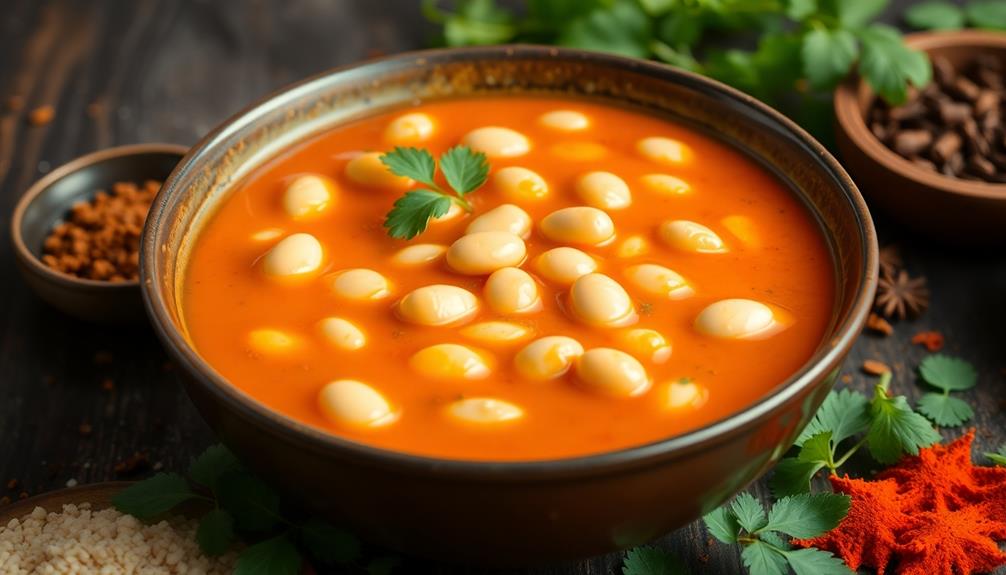Butter bean curry is a rich, creamy, and satisfying twist on classic curry that'll have your tastebuds dancing with joy. Originating in the South, these buttery beans add a velvety texture and comforting flavor that pairs beautifully with aromatic spices. The adaptable recipe allows you to tailor it to your dietary needs, whether you're craving a plant-based delight or a protein-packed meal. Simmered to perfection, the curry's harmony of earthy, fragrant, and indulgent notes will leave you coming back for more. You'll find serving suggestions and cooking tips that'll help you take your curry game to the next level.
Key Takeaways
- Butter bean curry offers a comforting, creamy twist on traditional curry, featuring the buttery flavor and velvety texture of the versatile legume.
- The dish combines aromatic spices, coconut milk, and tangy tomatoes to create a harmonious balance of flavors and textures.
- Adaptable to various dietary preferences, the curry can be customized to suit individual tastes, making it an appealing option for diverse palates.
- Pairing the curry with fluffy basmati rice or warm naan bread provides a satisfying and complete dining experience.
- Butter beans, the key ingredient, offer a protein-packed and fiber-rich component, making this curry a nutritious and wholesome meal choice.
History
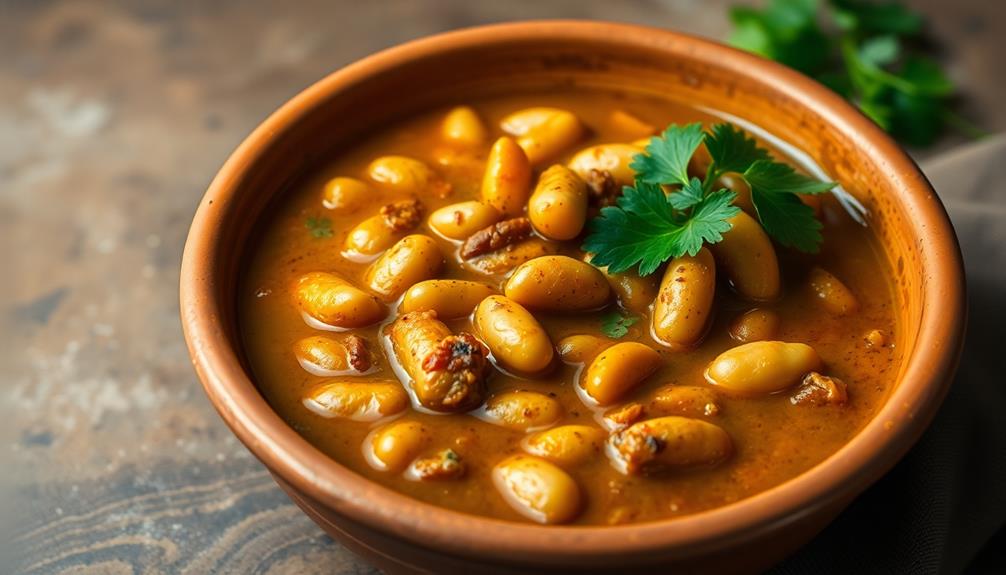
Originating from the southern regions of the United States, butter beans have long been a staple ingredient in traditional Southern cuisine. These plump, creamy legumes were initially cultivated by Native American tribes, who recognized their versatility and nutritional value.
Over time, butter beans became a beloved component in the diverse culinary tapestry of the South, finding their way into beloved dishes like succulent pork and bean stews, hearty vegetable medleys, and, of course, the delightful butter bean curry.
As the popularity of Southern fare spread across the nation, butter beans have gained increased recognition for their rich, buttery flavor and velvety texture.
Today, these versatile beans are enjoyed in kitchens worldwide, adding a delightful twist to a variety of international dishes. Whether simmered in savory broths, blended into creamy dips, or incorporated into vibrant curries, butter beans continue to captivate the palates of food enthusiasts, leaving a lasting impression with their comforting, homespun appeal.
Recipe

Butter bean curry is a delightful and comforting dish that combines the creamy texture of butter beans with a blend of aromatic spices. This dish is a perfect choice for a cozy meal, offering a satisfying and flavorful experience. With its roots in Indian cuisine, butter bean curry can be easily adapted to various dietary preferences, similar to how unique cake pop packaging enhances gift presentation and customer appeal.
Originating from the Indian subcontinent, butter bean curry is a versatile dish that can be enjoyed on its own or served alongside fluffy basmati rice or warm naan bread. The combination of the earthy butter beans, fragrant spices, and rich, velvety sauce makes this dish a true delight for the senses.
Ingredients:
- 2 cups cooked butter beans (or 1 (15 oz) can, drained and rinsed)
- 1 large onion, diced
- 3 cloves garlic, minced
- 1 tablespoon grated ginger
- 1 teaspoon cumin
- 1 teaspoon coriander
- 1 teaspoon garam masala
- 1 teaspoon turmeric
- 1 teaspoon paprika
- 1 (14 oz) can diced tomatoes
- 1 cup coconut milk
- Salt and pepper to taste
- Chopped cilantro for garnish (optional)
Instructions:
In a large skillet or saucepan, sauté the onion over medium heat until translucent. Add the garlic and ginger, and cook for an additional minute, stirring constantly.
Stir in the cumin, coriander, garam masala, turmeric, and paprika, and cook for 2-3 minutes, or until the spices are fragrant. Pour in the diced tomatoes and coconut milk, and bring the mixture to a simmer.
Add the cooked butter beans, and season with salt and pepper to taste. Simmer for 15-20 minutes, allowing the flavors to meld together. Serve the butter bean curry hot, garnished with chopped cilantro if desired.
For best results, adjust the spice level to your personal preference. If you enjoy a creamier texture, you can blend a portion of the curry mixture before returning it to the pan.
Additionally, consider serving the butter bean curry with a side of basmati rice or naan bread to soak up the delicious sauce.
Cooking Steps

First, soak your butter beans overnight, then drain and rinse them.
Next, sauté some onions and fragrant spices in a pan.
Step 1. Soak Butter Beans Overnight
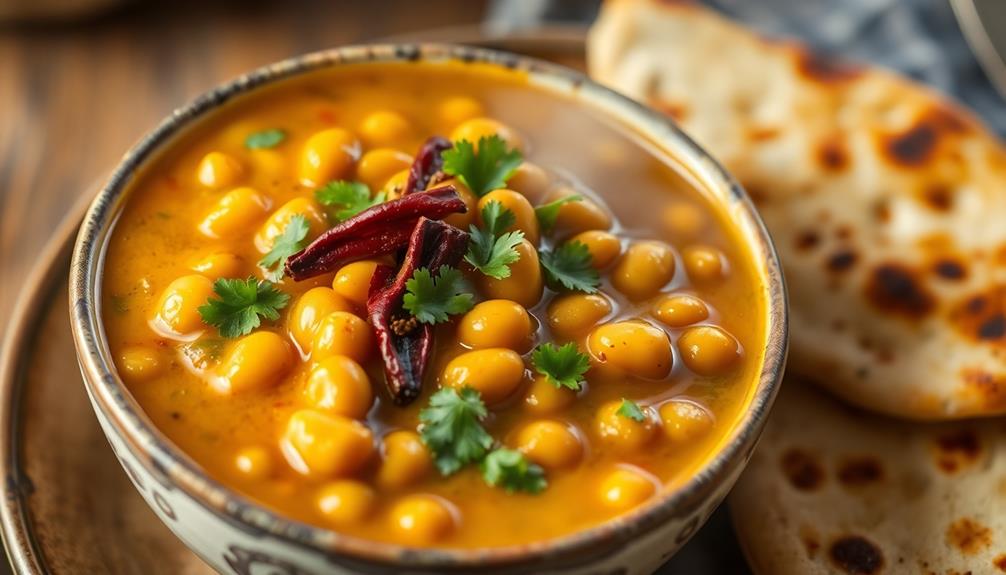
Before you can start cooking the butter bean curry, you'll need to soak the beans overnight. This important step helps to soften the beans and makes them easier to cook.
Simply place the dried butter beans in a large bowl and cover them with plenty of water. Let them soak for at least 8 hours, or overnight. You'll notice the beans expand and become plump as they absorb the water.
Once they're ready, drain and rinse the soaked beans. This quick prep work sets you up for success in the kitchen, ensuring your butter bean curry turns out rich, creamy, and absolutely delicious.
With the hard part out of the way, you can now move on to the next steps of the recipe. Get ready to be amazed by the deep, savory flavors of this satisfying curry dish!
Step 2. Drain and Rinse Butter Beans
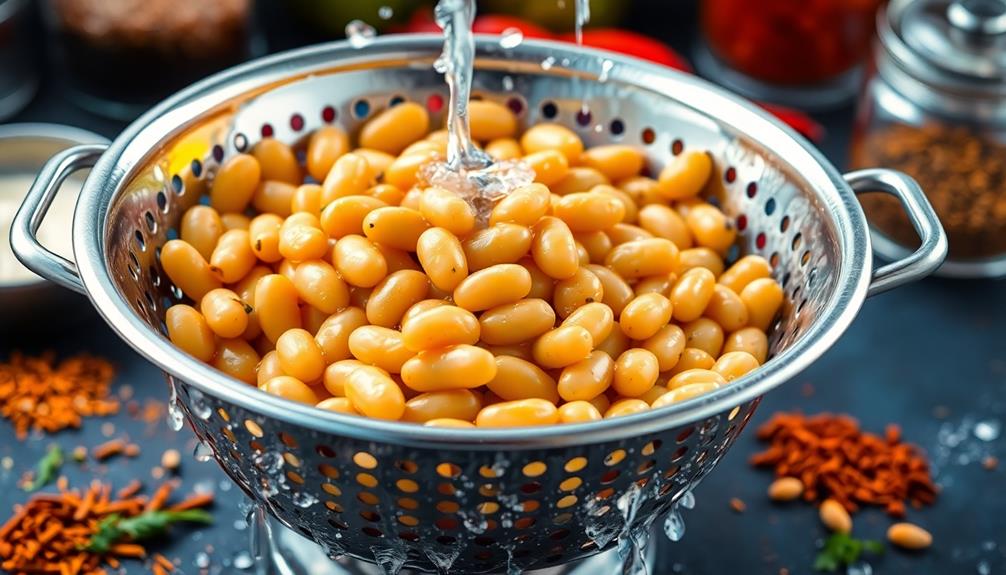
After the overnight soak, you'll need to drain and rinse the butter beans. This step is crucial to remove any excess starch and prepare the beans for the curry.
Grab a colander and place it in the sink. Carefully pour the soaked beans into the colander, letting the water drain out. Once drained, give the beans a thorough rinse under cool running water.
You'll notice the water becomes cloudy as you rinse – this is just the starch being washed away. Keep rinsing until the water runs clear. Gently shake the colander to help remove any remaining water.
Now your butter beans are ready to be added to the curry! This simple step ensures your finished dish will have the perfect texture and flavor. Don't skip it – rinsing the beans is a must for achieving that rich, creamy curry you're after.
Step 3. Sauté Onions and Spices

Now that the butter beans are drained and rinsed, it's time to start building the flavors for your curry. In a large skillet over medium heat, add a drizzle of olive oil.
Once the oil is shimmering, toss in the diced onions. Sauté the onions, stirring occasionally, until they're softened and starting to caramelize, about 5-7 minutes.
Next, add the minced garlic and grated ginger to the skillet. The aroma will instantly fill your kitchen, making your mouth water in anticipation.
Stir the garlic and ginger constantly for 1-2 minutes, being careful not to let them burn.
Now, it's time to introduce the warm, aromatic spices. Sprinkle in the cumin, coriander, and garam masala.
Give everything a good stir, coating the onions, garlic, and ginger in the fragrant spice blend. Allow the spices to toast for 1-2 minutes, releasing their essential oils and deepening the flavor.
Step 4. Add Coconut Milk and Simmer

The next step is to pour in the creamy coconut milk. This luscious, tropical ingredient will transform the dish, creating a rich, velvety texture that's simply divine. Coconut milk is also a great source of healthy fats, which can help with nutrient absorption and provide energy during cooking.
Go ahead and slowly pour it in, watching as it melds with the aromatic spices and tender onions. Stir gently to combine everything, then let the mixture simmer. As it bubbles away, the flavors will deepen and meld, creating a harmonious balance of spice, creaminess, and sweetness.
Be patient and allow the curry to simmer for about 15-20 minutes, stirring occasionally. This gives the coconut milk time to work its magic, infusing the dish with its signature flavor and creaminess.
Breathe in the heavenly aroma – can you almost taste it already? The butter beans will soak up all those wonderful flavors, becoming tender and infused with the essence of the curry.
Celery juice benefits get ready, because the next step is about to take this dish to the next level of deliciousness!
Step 5. Add Chopped Tomatoes and Simmer

Next, grab some juicy, ripe tomatoes and chop them up. The vibrant, red color of the tomatoes will add a lovely pop to your curry. Toss the chopped tomatoes into the simmering coconut milk.
As the curry continues to cook, the tomatoes will break down, releasing their tangy sweetness into the creamy sauce. This combination enhances the dish not only visually but also nutritionally, as tomatoes are known for their health benefits, including allergen reduction. Stir the mixture occasionally, allowing the flavors to meld together beautifully.
The addition of the tomatoes not only enhances the visual appeal of the dish but also adds a delightful depth of flavor. The acidity from the tomatoes perfectly balances the richness of the coconut milk, creating a harmonious blend that'll have your taste buds dancing.
Allow the curry to simmer for about 10-15 minutes, until the tomatoes have softened and the flavors have fully integrated. Get ready for a curry that's bursting with bright, tomatoey goodness in every bite!
Final Thoughts
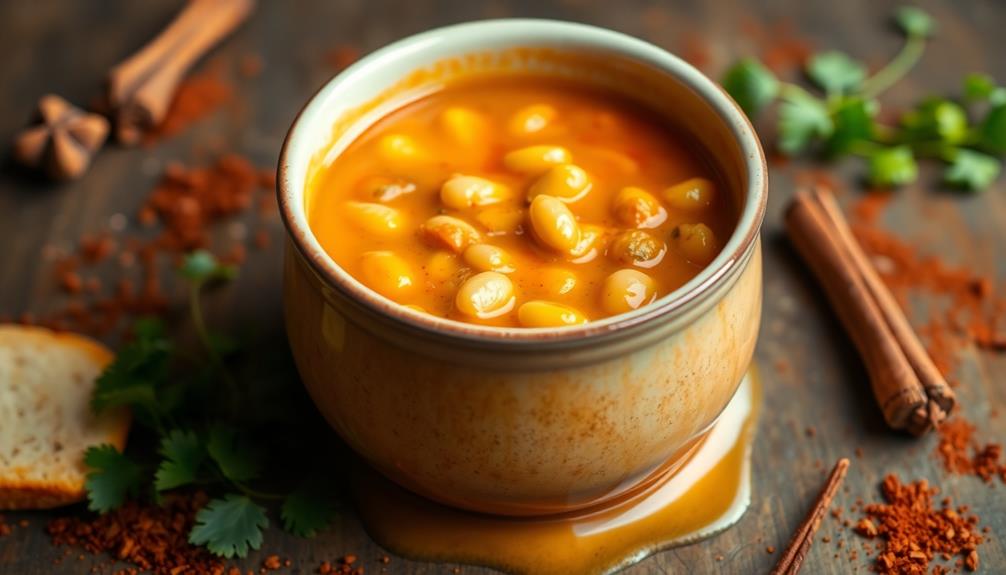
Though the butter bean curry may seem like a simple dish, it's a flavorful and versatile meal that can be enjoyed in various ways. The rich, creamy texture and complex blend of spices make this curry a real treat for your taste buds.
Don't be afraid to get creative and experiment with different toppings or sides – the possibilities are endless! You could serve it over a bed of fluffy rice, alongside some freshly baked naan bread, or even topped with a sprinkle of toasted coconut for an extra burst of flavor.
And the best part? This dish isn't only delicious but also incredibly nourishing, thanks to the protein-packed butter beans.
Frequently Asked Questions
Can I Substitute Other Beans for Butter Beans?
Absolutely! You can substitute other beans for butter beans in this recipe. Try kidney, chickpeas, or even lentils – they'll all work well and provide a similar creamy, satisfying texture to the dish.
How Long Does the Curry Keep in the Fridge?
The curry will keep in the fridge for 3-4 days. Store it in an airtight container, and make sure to reheat it thoroughly before serving. This will help maintain the flavor and texture of the dish.
Is This Dish Suitable for Vegetarians or Vegans?
This dish is suitable for vegetarians and vegans. The recipe doesn't contain any animal-derived ingredients, making it a plant-based, meatless option that caters to those following a vegetarian or vegan diet. Enjoy this flavorful and satisfying curry!
Can I Freeze the Leftover Curry for Later Use?
Yes, you can easily freeze the leftover curry for later use. The creamy texture and rich flavors will hold up well in the freezer, allowing you to enjoy this satisfying dish again at a later time.
What Side Dishes Pair Well With Butter Bean Curry?
You can pair butter bean curry with a variety of side dishes. Consider serving it with naan bread, rice, roasted vegetables, or a fresh salad to create a well-rounded and flavorful meal.
